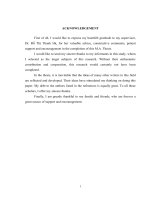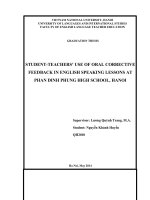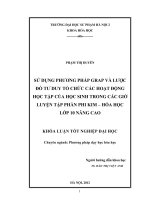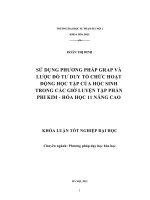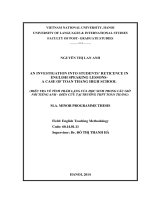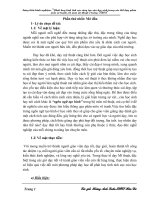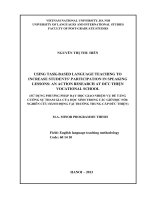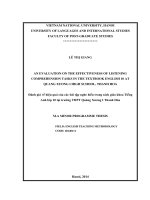điều tra về tính trầm lặng của học sinh trong các giờ nói tiếng anh điển cứu tại trường thpt toàn thắng
Bạn đang xem bản rút gọn của tài liệu. Xem và tải ngay bản đầy đủ của tài liệu tại đây (2.26 MB, 85 trang )
ACKNOWLEDGEMENT
First of all, I would like to express my heartfelt gratitude to my supervisor,
Dr. Đỗ Thị Thanh Hà, for her valuable advice, constructive comments, patient
support and encouragement in the completion of this M.A. Thesis.
I would like to send my sincere thanks to my informants in this study, whom
I selected as the target subjects of this research. Without their enthusiastic
contribution and cooperation, this research would certainly not have been
completed.
In the thesis, it is inevitable that the ideas of many other writers in this field
are reflected and developed. Their ideas have stimulated my thinking on doing this
paper. My debt to the authors listed in the references is equally great. To all these
scholars, I offer my sincere thanks.
Finally, I am greatly thankful to my family and friends, who are forever a
great source of support and encouragement.
i
ABSTRACT
Realizing many 11
th
graders at Toan Thang high school being passive in English
Speaking classes, this study aims to explore students’ perception toward their
reticence behaviour in real- world classes, factors contributing to it and students’
expectation. A total of 373 students enrolled in eight 11
th
grade classes, were first
observed in eight English Speaking lessons, and then filled in two sets of open-
ended questionnaire. After that, six of them were interviewed using semi-structured
format. A mix- method analysis is conducted to explore the findings. From the
study, it is revealed that students have strong willingness to participate in English
activities though they rarely do so in reality due to various learning misconceptions.
The result indicates that teachers need not only to use interesting, various and
suitable activities to encourage students to learn the target language but also to
explain and have more informal talks with students to teach them how to learn
effectively.
ii
TABLE OF CONTENTS
ACKNOWLEDGEMENT i
ABSTRACT ii
TABLE OF CONTENTS iii
LIST OF ABBREVIATIONS v
LIST OF TABLES AND GRAPHS vi
PART A: INTRODUCTION 1
1. Rationale 1
2. Aim of the study 2
3. Research questions 2
4. Scope of the study 2
5. Methods of the study 3
6. Design of the study 3
PART B: DEVELOPMENT 4
CHAPTER 1: LITERATURE REVIEW 4
1.1.Reticence behaviour in foreign language class 4
1.1.1.The concept of reticence 4
1.1.2.Interpretation of reticence 5
1.1.3.Consequences of reticence 6
1.2.Students’ reticence behaviour in English speaking lessons 7
1.2.1.Students’ participation in verbal interaction 7
1.2.2.Potential obstacles to students’ verbal participation 8
1.2.3.Teachers’ roles towards students participation 9
CHAPTER 2: RESEARCH METHODS OF THE STUDY 11
2.1.The fitness of case study to the research purpose 11
2.2.Participants and setting of the study 12
2.2.1.Participants 12
2.2.2.Setting of the study 12
2.3.Data collection 14
2.3.1.Data collection instruments 14
2.3.2.Data collection procedure 17
2.3.3.Data analysis procedure 19
CHAPTER 3: FINDING AND DISCUSSION 20
3.1.Findings 20
3.1.1.Students’ reticence behaviour in English Speaking classes 20
3.1.2.Factors affecting students’ behaviour 25
3.1.3.Students’ expectation 29
3.2.Discussion 31
3.2.1.To what extent do the students remain reticent in English speaking
classes, and what activities make them the most reticent? 31
3.2.2.What are students’ perception of their own learning behaviour and
factors influencing such behaviour? 32
iii
3.2.3.What are students’ perspectives on whether, and how, to move the
classroom to a more interactive mode? 33
PART C: CONCLUSION 35
1.Recapitulation 35
2.Pedagogical implications 36
3.Limitations of the study 38
4.Suggestions for further study 39
REFERENCES 40
APPENDIX 1: OBSERVATION TRANSCRIPT I
Observation Transcript 1 I
Observation Transcript 2 IX
APPENDIX 2: QUESTIONNAIRE (English) -Part 1 XVI
APPENDIX 3: QUESTIONNAIRE (English) -Part 2 XIX
APPENDIX 4: QUESTIONNAIRE (Vietnamese) -Part 1 XXII
APPENDIX 5: QUESTIONNAIRE (Vietnamese) -Part 2 XXV
APPENDIX 6: INTERVIEW QUESTIONS (English) XXVIII
APPENDIX 7: INTERVIEW QUESTIONS (Vietnamese) XXX
APPENDIX 8: DETAILED ANALYSIS RESULT FOR GRAPH 1 XXXII
XXXII
XXXIII
XXXIII
APPENDIX 9: DETAILED ANALYSIS RESULT FOR GRAPH 2 XXXV
APPENDIX 10: DETAILED ANALYSIS RESULT FOR GRAPH 3 XXXVI
iv
LIST OF ABBREVIATIONS
CLT Communicative Language Teaching
EFL English as a Foreign Language
ELT English Language Teaching
Ss Students
T Teacher
v
LIST OF TABLES AND GRAPHS
TABLE 1 Data collection procedure in brief Page 18
GRAPH 1 Students’ self evaluation- The frequency of
attending English Speaking Activities
Page 22
GRAPH 2 Students’ real participation in class Page 24
TABLE 2 Students’ self evaluation- The frequency of
attending English Speaking Activities (with
Mean, Mode, Median, Standard Deviation, p-
value and Standard Deviation formula in excel)
XXXI
GRAPH 3 Students’ evaluation of main factors affecting
their reticence
Page 26
TABLE 3 Students’ self evaluation- The frequency of
attending English Speaking Activities (with
Correlation coefficient formula)
XXXII
TABLE 4 Students’ self evaluation- The frequency of
attending English Speaking Activities (with
Spearman- Brown correction formula)
XXXII
TABLE 5 Students’ real participation in class (with p-
value formula)
XXXIV
TABLE 6 Students’ evaluation of main factors affecting
their reticence
XXXV
vi
PART A: INTRODUCTION
1. Rationale
Because of the increasing status of English as a world language, people in
Viet Nam in general and in my hometown of Tien Lang in particular are becoming
more and more aware of the importance of the spoken English. This awareness was
reflected not only during many daily informal talks but also officially in the national
English language curriculum (MOET, 2006) which required high school students to
be able to conduct conversations in English on familiar daily life topics. Despite this
expectation, many high school students have been observed to be either quiet,
uncooperative or to speak English with a trembling voice, make numerous
unnecessary pauses, or have shaking hands or legs, etc. during the lesson.
This study was motivated by my concern about the apparent reluctance of
Toan Thang high school students to participate in English- speaking class
interactions. The decision to look into students’ reticence at Toan Thang high
school was first inspired by my teaching and living experience with the students in
this school for more than three years. Such contact not only allows a valuable
rapport with members of this case but also encourages my interest in further
understanding students’ perception and expectation. Initial observations at the
selected location reveals that spontaneous discourse was rare in many English
speaking classes and many oral interactions not only did not include any students’
individual thoughts or elaborated responses but also fostered a great deal of
dependence on the teacher. As a result, both teachers and students have become
frustrated and often complained about the quality of the learning outcome. This
makes it urgent to examine this phenomenon to better understand the learning
situation at Toan Thang high school and ultimately enhance the learning and
teaching of oral English here. The second reason is my realization that students
themselves and students in different context (both educational context and
1
background) exhibit different behaviour and worldviews, which would contribute
diverse perspectives, experiences and insights into the topic of reticence. The above
reasons actually drive the researcher to a study thesis, namely “An investigation
into students’ reticence in English speaking lessons - A case of Toan Thang high
school”.
2. Aim of the study
The current study aims at:
• Exploring the nature of students’ reticence in English speaking lessons at
Toan Thang high school and some common situations for reticence to
flourish,
• Investigating students’ viewpoints of their own learning behaviour and
potential obstacles to their verbal participation in the classroom,
• Finding out students’ aspiration on whether, and how, to move the classroom
to a more interactive mode.
3. Research questions
(1) To what extent do the students remain reticent in English speaking classes,
and what activities make them the most reticent?
(2) What are students’ perception of their own learning behaviour and factors
influencing such behaviour?
(3) What are students’ perspectives on whether, and how, to move the classroom
into a more interactive mode?
4. Scope of the study
Within the framework of a minor M.A. thesis, the researcher only focuses on
the real situation of reticence happening among 11
th
graders in their English
speaking lessons at Toan Thang high school, as well as their various angles and
desires towards this issue.
2
5. Methods of the study
To achieve the aims mentioned above, the study adopts the methodological
approach of the case study using mixed methods for data collection. The tools for
data gathering include class observation, semi-structured interview and
questionnaire.
6. Design of the study
There are five main chapters in the thesis:
Part A: Introduction, which presents the rationale, aims, scope and research
questions.
Part B: Development including:
Chapter 1: Literature Review, which reviews theoretical foreground from the
previous studies on students’ reticence behaviour in general and in English speaking
classes in particular.
Chapter 2: Research Methods of the Study, which composes of 3 parts: the
fitness of case study to the research purpose, participants’ description and setting of
the study (the case), and data collection.
Chapter 3: Findings and discussion, which is the discussion of the findings
through an analysis of the data collected through means of researching:
observations, semi-structured interviews and questionnaire.
Part C: Conclusion, in which major findings of the study will be briefly
summarized as well as the acknowledgement of the limitations of the study will be
elaborated.
Besides, the classroom transcripts, interview transcripts, questionnaires and tables
of data analysis results are included in the Appendices.
3
PART B: DEVELOPMENT
CHAPTER 1: LITERATURE REVIEW
1.1. Reticence behaviour in foreign language class
1.1.1. The concept of reticence
The terminology of reticence in academic writing was first introduced in
1965 with Phillips’ article introducing to the field of speech communication and the
notion that some people had difficulty communicating across a range of situations.
After his groundbreaking contribution, reticence caught the attention of many
researchers and linguists under different cognate constructs such as reticence
(Keaten & Kelly, 2000), communication incompetence, communication
apprehension (McCroskey, 1970) and unwillingness to communicate (Burgoon,
1976). Their studies, no matter how different they were, agreed with Keaten and
Kelly on an affirmation that reticence was a communication problem with
cognitive, affective and behavioral dimensions and was due to the belief that one
was better off remaining silent than risking appearing foolish. (Keaten & Kelly,
2000)
My own standpoint of reticence is strongly influenced by Keaten & Kelly’s
affirmation, which has been narrowed down to a specific situation- English
Speaking classroom. Reticence, in this paper, refers to behaviour of reticents who
have a tendency to avoid communication, that is, to engage in chronic silence out of
fear of foolishness. They remain silence as a patterned response to the threat of
negative evaluation. The feeling of uneasiness, worry, nervousness and
apprehension experienced by non-native speakers when learning or using a second
or foreign language has now changed learners into reticents since they possess a set
of faulty beliefs about communication and foreign language learning process.
4
1.1.2. Interpretation of reticence
Since the beginning of reticence research, theories have been made relating
to what involved in reticence behaviour, and who often reveal themselves as
reticents.
First of all, reticence can indicate shyness characteristic. It includes attitudes
and feeling such as a lack of confidence particularly in new or unfamiliar social
settings, excessive preoccupation with self in the presence of others, inadequate
social skills, and disruptive anxiety and self-derogation in social situation. (Cheek
& Watson, 1989)
Second, reticence may imply too much inner speech overlapping one
another, which is conductive to depression, morbidity and anxiety (Tomlinson,
2001).
Third, reticence can communicate acceptance of the other person, but
without any doubt or any critical argument, which reveal passivity, lack of
creativity, shortage of knowledge, justification and inventive skills.
More often, reticence brings to light the fact that such people have no interest
on the situation they are involved. It can also be a token of not understanding,
which might be resulted from being involved in conversation or lessons with
complicated, difficult or above- level topics.
In addition, most people experience occasional feelings of shyness as a
transitory reaction when encountering certain difficult social situation. (Russel,
Cutrona & Jones, 1986; Zimbardo, 1977). Likewise, some individuals are fearful
and nervous of any unprepared situation that may cause unexpected results. They
can’t risk themselves for any uncertain challenge. (Ely, 1986; Liu & Jackson, 2008)
Again, the above correlations between environmental factors and
communication reticence were detected and proved by many linguists’ studies. The
results indicated that reticence is significantly influenced by antecedent
environmental factors, thus lending support to etiological explanations based on
learning theory and perception theory.
5
1.1.3. Consequences of reticence
In many cases, the reticence behaviour is not simply resulted from one or
several reasons in some certain situations, but more often, a final manifestation of
serial complicated reactions during interactions such as tension, inhibition,
awkwardness, painful self-consciousness, physical distress, and worry about being
evaluated negatively. It comes along with somatic anxiety symptoms such as upset
stomach, pounding heart, sweating, trembling or blushing, which can lead to
stressfulness and depression. If reticence is not treated carefully, it can have serious
repercussion for the reticents’ heath themselves.
Reticence in a specific situation of foreign language classes resulted in a
series of failure. As involvement and participation are essential for language
acquisition, the more utterances the learners offer, the better their spoken language
is and vice versa. This phenomenon is known as ‘Matthew Effect’, that is "rich get
richer, poor get poorer" (Chau, 1996). Students, who are actively involved, reported
higher satisfaction and higher persistence rates (Tsui, 1996).
Furthermore, the act of being silent, reluctant to participate or speak using
the target language has always been considered as the main source of frustration,
and failure for not only students but also instructors (Flowerdew & Miller, 1995;
Jackson, 2002), which is essentially important when the conceptualization of the
Communicative Language Teaching approach is implemented. This negative
behaviour or passive attitude disrupts not only instructional plan, it also makes it
hard for instructors to facilitate active learning among students. As a conspicuous
consequence, it restricts students from progress, and intended course learning
outcomes might not be achieved. Moreover, most of the time, instructors have to
struggle in exploring ways to break the uncomfortable silence in interaction in order
to minimize the feeling of discombobulating.
In short, students’ reticence, withdrawal, or fear of interacting not only
deprives them of sharing what they know, but also deprives the teacher and
6
classmates of benefiting from it. Thus students’ reticence has a vital influence in
teaching and learning process and there is a need for an individual, teacher and
classmate to reduce or eliminate such phenomena.
1.2. Students’ reticence behaviour in English speaking lessons
1.2.1. Students’ participation in verbal interaction
In spite of the growing expectation for verbal classroom participation in
second and foreign language learning situations, reticence research has captured the
attention of language theorists and educators in recent decades. From his
observation and experience of teaching the EFL speaking skills for more than 15
years, Hilde (2009) has noticed that most of the students who enroll in the English
Department of Qassim University have revealed reticence in speaking activities.
Non English major students in Saudi Arabia, similar to learners in foreign language
contexts (Jackson, 2002; Howritz et al, 1986), have been observed to be either quiet
or to speak English with a trembling voice, make numerous unnecessary stops, or
having shaking hands or legs, etc. during English lessons or oral English tests. The
same problem has also been observed in other Asian countries. Dick and Robinson
(1995, p. 5) reported that Malaysian students “preferred not to say anything during
lecture discussion sessions” and “if an instructor asked a question, the class would
become deadly silent”. Korean students “speak only when invited by their
instructors” and Japanese students are “nervous about asking questions in class”
because they are unsure if a question was appropriate and they would choose “to
ask questions after class, only with teachers” (Chen, 2003, p. 267- 268).
In Vietnam, many students, after over ten years of schooling toward
intellectual maturity, have not demonstrated their basic communicative skills;
rather, there is an identifiable reticence, a reluctance to speak out in class and an
apparent unwillingness of students to express themselves which, to outsiders, may
be construed as a lack of motivation or shyness (Bao, 2013). In the classroom,
7
Vietnamese students’ culture of learning can be described as one in which students
depend heavily on the pedagogical tendency of many teachers to transmit
knowledge about the subject content (Bui, 2004).
This makes it urgent to examine this phenomenon to better understand the
causes of the students’ reluctance to participate in the English language classroom
and ultimately enhance the learning and teaching of oral English there.
1.2.2. Potential obstacles to students’ verbal participation
Originated from Burns and Joyce’s identification (Burns & Joyce, 1997),
there are three sets of factors that might cause the reticence in classroom activities
involving speaking: cultural factors, linguistic factors and psychological/affective
factors. The cultural factor here is understood as cultural attributes of Asian
societies which are often cited as the main causes for such alleged behaviour of
reticence and passivity. It was then widened by Cheng (2003) who used the two
terms “result of Confucian culture and tradition” and “previous learning
experience” as well as Bao (2013) with a more general name of “external forces”.
Linguistic- related factor is secondly mentioned as causing reticence.
Manifestations of communication apprehension in the EFL have been reported by
Lucas (1984, as cited in Aida, 1994) and Foss & Reitzel (1988, as cited in Aida,
1994), giving support to the idea that “people experience anxiety and reluctance in
communicating with other people or in expressing themselves in a foreign language
in which they do not have a full competence” (Aida, 1994). Moreover, reticence
relates to self-esteem & self-acceptance and whoever possesses an introvert and shy
personality often reveals reticence in class, especially foreign language classes.
According to Hui (2011), a student’s reticence in class not only reveals that
he/ she is unwilling to talk in certain circumstances; it could also indicate any of the
following symptoms:
(1) the student’s apathy toward the topic at hand or to the learning process itself;
(2) the student who is not comprehending is overwhelmed, or is bored;
8
(3) the student is isolated from the learning community;
(4) the student has not learned the value or strategies of engagement or he/ she
does not appreciate or believe in that value.
Additionally, reticence can be the result of high tension beween the new
approach and learners’ traditional perception (Jarvis, 1986; Little & Sanders, 1990).
To sum up, there are a variety of factors that lead students to being reticence.
These factors, however, may not operate in isolation and as Van Worde (2003, p.5)
affirms, but are likely to be intertwined.
1.2.3. Teachers’ roles towards students participation
Teacher is considered to be the key factors that influence students’ behaviour
in class. Such conclusion is supported by a study of 100 Vietnamese university
students. More than 90% of the respondents had studied English for at least eight
years before completing the survey that focused on causes of demotivation in
learning English, which may lead to reticence behaviour: “The largest source of
demotives was related to teachers”, “within the four demotive categories related to
teachers, teaching methods provided the largest source of demotives” (Tran &
Baldauf, 2007). Reticence can be influenced directly by the teaching methods,
questioning methods, error correction, English proficiency and characteristics of the
teacher or indirectly by teacher’s belief, the classroom habits that he/ she formed to
the students and what he/ she often teaches the students besides the English
knowledge.
First of all, the fact that teachers themselves have poor English language
competence leads to students’ boredom, tiredness, doubt and finally students’
reticence. Le (2002) reported that despite the strong promotion of CLT, the lack of
appropriate in- service professional development meant that “teachers are generally
incapable of teaching English communicatively in their real- world classroom.
Instead, they spend most of their lesson time explaining abstract grammar rules and
guiding their students in choral readings.”
9
Secondly, it is teacher’s misconception about students’ ability that causes
students’ consciousness of being underestimated or neglected, which finally leads to
reticence behaviour. A survey by Tomlinson & Bao (2004) demonstrated that many
teachers do not wish to change their methods, with more than half the respondents
not wishing to participate in intervention for change, and some refusing to believe
that the learners were willing to participate and refusing to believe in the potential
of learners to express themselves fluently in English.
On the other hand, in preparing their students for such exams, teachers fail to
implement communicative approaches in their classrooms and use teaching
methods relevant to the students’ goals of passing the exams (Kim, 2006).
Moreover, some teachers seem to overuse their authority, which is considered a
main source of inhibiting students’ verbal performance. Many teachers remain too
conservative to accept different ways of viewing the same issue (Bao, 2004).
In brief, the influence of the teacher’s traditional role over students’ attitudes
toward classroom participation is indicated in four main tendencies. One view
highlights teachers’ unchallenged expertise and self- complacency as a cause of
poor teaching performance which leads to poor participation. Teachers’ positive
qualities are a stimulus to active collaboration and enthusiastic participation. A
second view implies that teacher frequently helds misconception about students’
potential, which is a possible reason for students’ reticence in class. A third view
suggests that teachers’ strong emphasis on the written test and high score prevent
students from actively involved in the Speaking lesson. Last but not least, teachers’
overused authority is considered to be one factor that induces fear and silence
among learners.
10
CHAPTER 2: RESEARCH METHODS OF THE STUDY
This chapter is to present research methodology I choose to achieve the aims
and objectives of the study. It gives out thorough explanations of reasons for
choosing the research instruments, and clarifies specific way of getting information
through those instruments.
2.1. The fitness of case study to the research purpose
Case studies, as described by Yin (2003), are “the preferred strategy when
“how” or “why” questions are being posed, when the investigator has little control
over events, and also when the focus is on a contemporary phenomenon within
some real-life context” (p.1). Yin also goes on to assert that the case study method
allows the researcher to get insights into the holistic and meaningful characteristics
of real-life events (p. 2). This thesis matches the above conditions as it aims at
discovering Toan Thang high school students’ perception toward their reticence
behaviour in its natural context, i.e., in the classroom.
A case can be defined in a variety of different ways, but fundamentally is
referred to as a ‘bounded system’, a term originally coined by Louis Smith (n.d.,
cited in Stake, 1995). However, the notion of ‘boundedness’ is complex at the
operational level. In this study I used Hitchcock & Hughes’ definition of
‘boundedness’ (Hitchcock & Hughes, 1995, p.319) according to which a case can
be “looked at in terms of ‘key players’, ‘key situations’ and ‘critical incidents’ in
the life of the case” (McDonough, 1997, p. 205). Information about the case in this
study regarding the above aspects is presented in the subsequent section.
With regard to typology, Yin (2003) categorizes case studies into three main
types: (i) exploratory case studies; (ii) descriptive case studies; and (iii) explanatory
case studies (p. 1). The current case study of Toan Thang high school is a
combination of an exploratory study and a descriptive study. It is exploratory in the
11
sense that it sets out to explore students’ reticence from their own point of view. But
it is descriptive, too, because it aims to describe the extent to which the students
remain reticent in real English Speaking classes.
2.2. Participants and setting of the study
2.2.1. Participants
The voices to be heard in the study are those of 373 students, age between 17
and 18, from one intermediate level class (receiving four periods of English per
week) and seven preliminary level classes (receiving three periods of English per
week). Such levels were named by the school administration based on students’
average score after each semester. The choice of 11
th
graders, which covered
between two and three years of learning experiences at this school, allowed the
students not only to discuss their present English classes but to reflect on the history
of studying in previous classes. Among 373 students being investigated, 193
students are male and 180 are female. Most of them come from poor or middle-
income families in the rural area. Due to the lack of information and technology,
students have little chance to access English in different ways. Almost all the 11
th
graders being investigated (96, 5%) have never met foreigners before and half of
them have no intention of continuing to use English after class or after graduation.
Only 21 per 373 students (5, 6%) plans to choose subjects in group D to enter
university and college. (Lương Trường Xuân, 2014)
2.2.2. Setting of the study
The analysis was carried out as a case study of Toan Thang high school. This
is a state- run school located in Tien Lang district, which is about 30 kilometer from
Hai Phong city center. The inhabitants here live mainly on farming, deep-sea
fishing, and a wide range of traditional handicrafts. There isn’t any English club or
center operating at the moment in this area.
12
At this school, students attend 5 obligatory periods in the morning and three
optional extra- classes in the afternoon. Eleventh graders follow the curriculum
promulgated by the Ministry of Education and Training, with a weekly English
class time of 135 minutes, split into three lessons of 45 minutes each. Only students
from class 11B8, the intermediate level class, get another lesson every week,
namely ‘elective lesson’. However, they all study the Basic English textbooks,
which is theme-based and skill-based.
With regard to facility and technology, the overview reveals a bad image of
inadequate facilities, resources and learning environments as well as backward
technology. There is a lack of conductive equipments such as flexible seatings and
even consistent power supply. The boards, which are all chalk boards rather than
whiteboard, bulletin, flannel or felt boards, are in poor condition. The library that
provides a limited amount of audio visual teaching aids like projectors, radios, or
pictures does not have many kinds of English books to borrow. Furthermore, the
inconvenience of bringing all those stuff to class and installing a projector or a
laptop prevents teachers from daily use in their real-world classes.
Although in grade 11, there is one selective class which is reported to have
higher average score than others, the English proficiency among students in the
same class is unequal. Large class sizes of mixed-level students (between 44 and 48
students), which confuses teachers, is also a disadvantage in every English
Speaking lessons. Additionally, in order to maintain high disciplinary standard,
Toan Thang high school has implemented many strict rules and harsh punishments
against undisciplined individuals and classes. Students are required to wear
uniforms and badges, take notes carefully and keep quiet during the lessons no
matter what they are studying. Everyday, they are watched by a group of teachers
and students from the school disciplinary team.
As far as the testing system is concerned, none of the examinations at this
school seek to measure communicative competence. This is the result of large- scale
non- communicative testing that continues to be the norm of Vietnam educational
testing system. Despite the aim of students achieving communicative skills, the
13
Ministry has institutionalised multiple-choice tests as the only testing method for
standardised high- stake tests. In these tests, pupils are tested in terms of phonetics,
grammar, vocabulary and reading comprehension. Speaking and listening are not
tested.
2.3. Data collection
2.3.1. Data collection instruments
For the purpose of this study, a triangulation of three different methods was
used for data collection. These included classroom observation, questionnaire and
semi-structured interviews.
- Classroom Observation:
According to Hopkins (cited in Mr Donough, J. & Mr Donough, S., 1997,
p.101), observation is a pivotal activity with a crucial role to play in classroom
research. In this study, observation is a helpful tool for the researcher in three main
dimensions: –to investigate whether reticence is the manner found in some specific
aspects and individuals or a frequent display among students in different classroom
circumstances; – to investigate the implementation of teaching methodology in
reality, which may contribute to students’ reticence development; – to know the
way of cooperations and interactions between students and students, and between
teacher and students, through the task process. To fulfill those aims, the researcher
focused on observing the whole class events at the level of activity and analyzing
the communicative features of verbal exchanges between students and teachers
within each activity. The communicative features observed include the use of the
target language, information gap, sustained speech, the students’ readiness to
answer, as well as their mood and behaviours.
In order to capture all necessary aspects in the classroom life during the
observations, which is time-controlled, and to avoid observer-biased information,
14
taking notes, video- recording and audio- recording were used interchangeably
without letting the students notice. Furthermore, the fact that at least once every
week, students at Toan Thang high school welcomes teachers from other classes to
observe their class as well as the familiarity and friendly relationship between the
researchers and students help the researcher to approach the nature of the class.
- Questionnaire:
There are two sets of questionnaire used in this study, which consists of 14
questions that sought information to answer the three research questions:
(1) To what extent do the students remain reticent in English speaking classes,
(Question 1 and 3) and what activities make them the most reticent (Question 8)?
(2) What are students’ perception of their own learning behaviour (Question2, 4,
5, 6, and 7) and factors influencing such behaviour (Question 13 and 14)?
(3) What are students’ perspectives on whether, and how, to move the classroom
into a more interactive mode (Question 9, 10, 11 and 12)?
Each items in the questionnaire was either structured, open-ended, or both.
The questionnaire was first written in English and then, to ensure clarity for
respondents, was translated into Vietnamese. Since it contains a large number of
items, which could have affected the concentration span, the interest and the
willingness to answer of teenagers, I decided to administer it into two parts which
were delivered twice in each class. Part 2 seeks for factors affecting students’
reticence behaviours while part 1 asks about the rest issue.
The rationale of this questionnaire originated from Burns and Joyce’s
identification of three sets of factors explained in chapter 2 of this study (Burns &
Joyce, 1997) that might cause the reticence in class. Furthermore, it consisted of
items extracted from instruments used in previous studies, including:
-Bao Dat’s questionnaires (Bao, 2013; Bao, 2014) to create the 2
nd
questionnaire of
this research;
15
- Chen Meihua and Wang Xuehua’s questionnaire (Chen & Wang, 2013) to
construct question 3 in the 1
st
questionnaire;
- The second section of the questionnaire in Young’s research (Young, 1990) with
twenty different in-class activities to set up question 8 in the 1
st
questionnaire of this
thesis.
However, the final set of questionnaires used in this study is a result of the
researcher’s preliminary investigation rather than attaching other studies’ outcomes.
A series of eight observations in the case context mentioned above as well as five
pilots carried out among 10
th
and 12
th
graders at Toan Thang high school and 11
th
graders at Tien Lang high school play a crucial role in modifying the original
questionnaires. Thus, terminologies and difficult expressions are eliminated and
replaced by easily- digested words and explanations.
- Interview:
Interviewing is an effective research instrument to get full understanding of
any aspects in classroom life as it is more natural than questionnaire or some of the
other instruments. With the same planned questions, the answers of interviewees
may be much various, optional, unpredictable, and different from the methods that
let the answerers graph on paper sheets. It can provide realistic information for later
thought and therefore, can be used in ancillary role as a checking mechanism to
triangulate data gathered from other sources (Bryman, 2008). However,
interviewing has its own fails such as the difficulty in controling interviewees’
answers and the time. The researcher, therefore, must be sensitive, active and tactful
in the way of arousing question and eliciting answers.
Despite all those disadvantages, a semi- structured interviewing is suitable to
this case study. Six students (three males and three females) from the number of
participants above, based on their availability, voluntariness and the level of
thoughtfulness in their questionnaire responses, were interviewed regarding their
practice of English speaking in class, views on reticence and interactive mode and
16
suggestions to better the class environment. Pseudo names were used during the
investigation instead of their real name to protect respondents’ privacy: Lan, Mai,
Hoa, Nam, Tuấn, Hùng (from class B1,2,3,4,7,8). The interviews were recorded so
that interviewers can focus fully on talking, using suitable body language and
understanding students rather than wasting time taking notes during the interviews.
The interview transcript, however, was made afterward to improve implication
process.
2.3.2. Data collection procedure
At the beginning of the second sememester, eight classroom observations
were conducted at the case context. These are all morning classes which vary from
the first to the fifth period. After two weeks of observation and three weeks of
study, the primary questionnaire and interview research were set up. Then, they
were tested to ensure their understandability, suitability and usefulness towards the
research’s purpose. Five pilots were implemented at Toan Thang high school with
grade 10 and 12, and grade 11 at Tien Lang high school- a school located at the
same district. The questions and designs were tested, refined and modified at the
same time to ensure the timing and budgeting issues. To prepare for the main
course, 13 teachers and administrators were asked for permission to let the
reseacher administer the investigation in 8 eleventh- grade classes twice, each time
for 30 minutes. The two questionnaires were delivered one week apart in order for
each student to attend one more Speaking lesson and have a thorough rethink before
deciding their answer. The aim of the questionnaires was introduced to the students
so as to collect information relating to a ‘communicative class model’ (Mô hình lớp
học theo đường hướng giao tiếp) rather than their reticence behaviour to avoid any
shyness and bias. The respondents were given some time to write their own
responses in the absence of the researcher, but clear explaination was already
exhibited at the beginning of the investigation. The teachers managing the classes
were instructed to give direction to the students and the researcher was willing and
17
accessible at any time during the investigation. Finally, a semi-structured interview
was employed, which was conducted with a selected number of various respondents
who seemed to have complex ideas to share and who represented interesting views
which invited further attention. The participant selection method relies on the
voluntary and available nature of participants at the case context. Table 1 below
provides a brief data collection procedure involved in the study.
TABLE 1: Data collection procedure
W
e
e
k
Methodology Location
In the morning In the afternoon
1 Classroom
observations
1
st
2
nd
3
th
4
th
5
th
1
st
2
nd
3
th
4
th
5
th
B1
B2
B3
B4
2 Classroom
observations
B5
B6
B7
B8
3,
4,
5,
6
Questionnaire
pilot study
10C5 &12A2
(Toan Thang high school)
11B1, 11B2, 11B7
(Tien Lang high school)
7 Questionnaire
part 1
B1 B2
B3 B4
B5 B6
B7 B8
8
9 Questionnaire
part 2
B1 B2
B3 B4
B5 B6
B7 B8
10 Interview Lan Mai Hoa Nam Tuấn Hùng
18
2.3.3. Data analysis procedure
Data analysis pays more attention to in-depth interpretation than factual and
verbatim in reporting participants’ voices. Such methods are highlighted by
Wellington (2000) and Bryman (2004) as thoughtful way to decode themes and
meaning in empirical data. Observation transcript assemble key factors toward
research aims during the lessons such as teacher- students interaction, the
uncommunicative mode, teacher and students’ activities, behaviours and other
related elements. Similarly, the researcher made use of the information from the
questionnaires by collecting statistics, comparing the frequency of responses as well
as the relationship between different variables. The main issues raised in the
analysis of the questionnaire responses were followed up by in- depth interviews.
To explain participants’ perceptions, transcriptions of their responses to interview
questions are processed through content analysis in which their words are
categorized, termed and interpreted so as to capture thoughts, behaviour and
viewpoints. Such processes of how categorization combined with interpretation
produce research outcome are well supported by Cohen et al. (2011), Creswell
(2008), Hesse-Biber & Leavy (2004) and Maxwell (2005). The researcher also
compared and linked the findings to those in the relevant literature for further
insights.
In order to keep data analyses as unbiased as possible, efforts have been
made by refraining from heavy reliance on researcher’s previous knowledge and by
only employing it to make connections among key issues. Such a stance has been
recognized by theorists including Bryman (2008), Asher (1965) as essential in
interpretive research inquiry.
19
